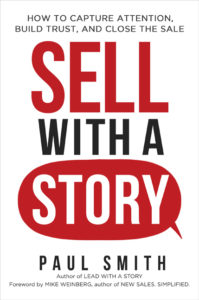Podcast: Play in new window | Download | Embed
Subscribe: RSS
Podcast (sell-with-a-story-series1): Play in new window | Download | Embed
Subscribe: RSS
Today’s article is the second in a series of the 25 most useful sales stories salespeople should be able to tell. As a reminder, those 25 are the result of my interviews with professional sales and procurement managers at over 50 companies looking for where salespeople are most effectively using storytelling throughout the entire sales process. The full results of those interviews are documented in the book, Sell with a Story.
 For this story, we’re still in the earliest phase of that process, where the salesperson is just introducing themselves to the prospect. And the second story you’re likely to find useful in this phase is called a “Who I’ve Helped and How I’ve Helped Them” story.
For this story, we’re still in the earliest phase of that process, where the salesperson is just introducing themselves to the prospect. And the second story you’re likely to find useful in this phase is called a “Who I’ve Helped and How I’ve Helped Them” story.
This kind of story provides real examples of customers you’ve helped and how you’ve helped them. They work so much better than the vague management-speak from your sales brochure about your “value-added services” and “best-in-class quality standards.”
As sales consultant Mike Weinberg explains, “Your goal with stories at this stage is to entice the prospect into meeting with you—to give them a glimpse of what they’ll miss out on if they don’t talk to you later.”
Here’s a real example of what that looks like when it’s done well from the perspective of a prospect. In this case, that prospect is Quave Burton, a global procurement executive at Abercrombie & Fitch.
 In July 2015, Quave attended a strategic sourcing forum in Newport Beach, California. Part of the conference included a networking exercise the attendees jokingly refer to as “speed dating.” Buyers and sellers chose who they’d most like to meet during the networking period. Then they got 30 minutes with each one at a table before rotating to the next one.
In July 2015, Quave attended a strategic sourcing forum in Newport Beach, California. Part of the conference included a networking exercise the attendees jokingly refer to as “speed dating.” Buyers and sellers chose who they’d most like to meet during the networking period. Then they got 30 minutes with each one at a table before rotating to the next one.
One of Quave’s six “dates” that day was Ben Koberna, CEO of Electronic Auction Services, Inc. (EASI). EASI runs reverse auction services for buyers. The company essentially gets multiple suppliers to bid on the contract to supply whatever it is the buyer needs.
 Quave’s responsibilities are primarily buying indirect goods and services for Abercrombie. That’s everything Abercrombie buys for its stores that does not become a part of the clothing: utilities, travel services, IT software and hardware, etc. And that’s exactly the kind of items EASI has the most experience with, which is why Ben wanted to meet with Quave.
Quave’s responsibilities are primarily buying indirect goods and services for Abercrombie. That’s everything Abercrombie buys for its stores that does not become a part of the clothing: utilities, travel services, IT software and hardware, etc. And that’s exactly the kind of items EASI has the most experience with, which is why Ben wanted to meet with Quave.
But that day, Quave wanted to know if the same kind of reverse auction could work for services or direct materials. EASI had almost no experience with the direct side. So, in order to convince her it would be worth her time to meet with him later, Ben would have to take one of the only experiences EASI had with direct materials auctions and make it work for him. So, he told her about his experience with a world-famous luxury clothier headquartered in New York. Here’s how he told it:
They normally deal with three suppliers for their cashmere program—two in Scotland and one in Italy. But this year, they received a fourth bid, from a manufacturer in China. Their normal suppliers usually bid between $165 and $175 per roll. But the Chinese supplier’s bid came in at $125 a roll. On a $3 million program, that 30 percent savings would be huge, so it was going to be almost impossible to turn down.
What they needed to know was what were the best prices available from all their suppliers so they could determine if the risk of going with the new Chinese supplier would that be worth the savings. So that’s exactly what we helped them do.
Since the Chinese supplier was obviously going to be the low bidder, we ran a reverse auction that really just included the other three bidders. We put in the $125 bid once at the beginning so they would all know there was another supplier that had a low bid. But the goal was really to get the other three to sharpen their pencils. We contacted all of the suppliers and explained how the process would work. Then over the course of about 45 minutes, we ran the auction. Each supplier had several chances to bid and rebid as the price dropped.
At the end of the time, all three suppliers had lowered their bids, but not enough to match the Chinese bid. But that didn’t matter. The auction had given them a true picture of the market pricing. Plus, EASI’s process also collects other information about the suppliers their client might not normally have access to. And that’s when their procurement director really got to earn a seat at the decision-making table. In a normal situation, the product people and the CFO might have negotiated among themselves. But the auction process gave procurement a bigger role to play than usual.
And that’s all Quave needed to hear. She made arrangements to meet with Ben the next week for a full demonstration of EASI’s service. And she still had 15 minutes of her “speed date” left to grab a coffee.
If you don’t have your own story like this, get one. It’s the shortest path from “Hello, nice to meet you” to “When’s a good day for me to stop by your office?
Here’s how to get started. Use Ben Koberna’s story about the cashmere auction as a guide:
- Choose an actual client in a typical industry you serve. (You don’t need to reveal the client’s name.)
- Sketch out a brief outline of the events that led up to the client’s needing your product or service—in other words, the background and the problem or opportunity the client encountered.
- List the main steps of what you or your product did for the client.
- Explain the outcome in terms of how it benefited the customer (e.g., “And that’s when the procurement director really got a seat at the decision-making table”).
That’s it. Now you’ve got your own “Who I’ve Helped and How I’ve Helped Them” story. Next time, we’ll talk about sales story #3: Stories salespeople tell themselves to get motivated for their next big sales call. Or, click here to see a list of all 25 sales stories.
Source: Sell with a Story: How to Capture Attention, Build Trust, and Close the Sale, by Paul Smith.
—
 Paul Smith is one of the world’s leading experts on business storytelling. He’s a keynote speaker, storytelling coach, and bestselling author of the books Lead with a Story, Parenting with a Story, and Sell with a Story.
Paul Smith is one of the world’s leading experts on business storytelling. He’s a keynote speaker, storytelling coach, and bestselling author of the books Lead with a Story, Parenting with a Story, and Sell with a Story.


 Connect with him via email here.
Connect with him via email here.
Follow him on Facebook, LinkedIn, Twitter, and Instagram.
Sign up for his newsletter here to get one new story a week delivered to your inbox.

